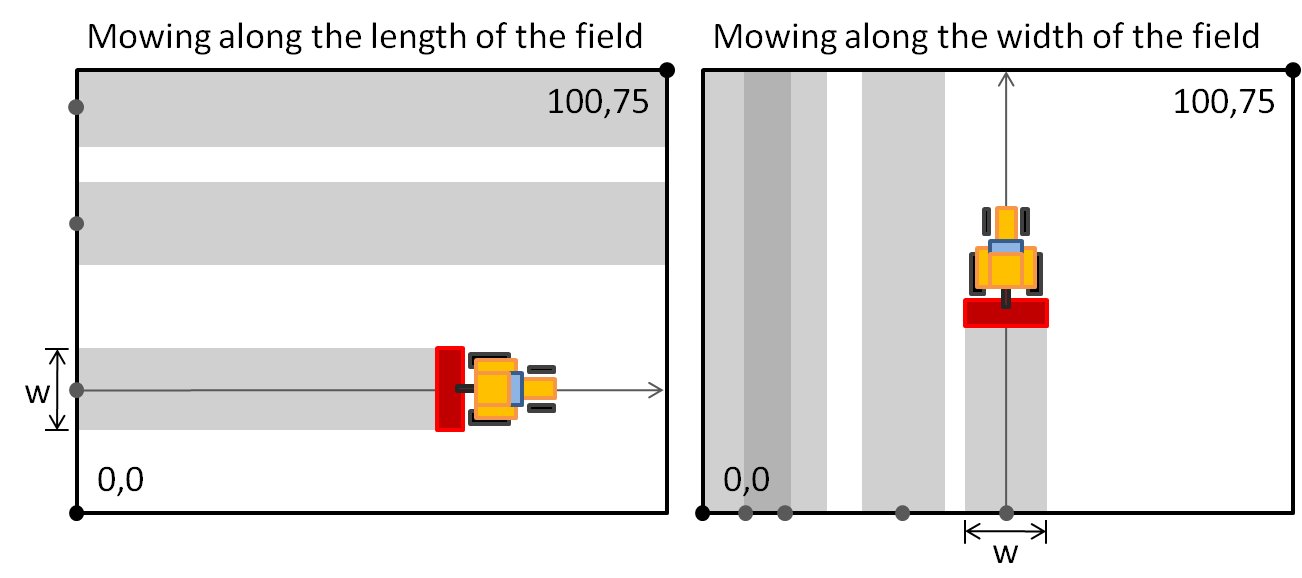| Submit | All submissions | Best solutions | Back to list |
LAWNMWR - Lawn Mower |
The International Collegiate Soccer Competition (ICSC) is famous for its well-kept rectangular stadiums. The grass playing fields in ICSC stadiums are always 100 meters long, and 75 meters wide. The grass is mowed every week with special lawn mowers, always using the same strategy: first, they make a series of passes along the length of the field, and then they do the same along the width of the field. All passes are straight lines, parallel to the sides of the field.

The ICSC has hired a new lawn-mower, Guido. Guido is very chaotic, and instead of covering the field incrementally, he likes to choose random starting positions for each of his passes. But he is afraid of not doing a good job and being fired by the ICSC, so he has asked you to help him. Write a program to make sure that the grass in the field is perfectly cut: all parts of the field have to be mowed at least once when the mower goes from end to end, and again when the mower goes from side to side.
Input
Each test case contains 3 lines. The first line contains two integers, nx (0 < nx < 1 000) and ny (0 < nx < 1 000), and a real number w (0 < w ≤ 50), which represents the width of the cut of that particular lawn mower. The next line describes the end-to-end passes (along the length of the field), and contains nx real numbers xi (0 ≤ xi ≤ 75) describing the starting positions of the mower’s center in Guido’s end-to-end passes. The last line describes the side-to-side passes, with ny real numbers yi (0 ≤ yi ≤ 100).
The end of the test cases is signalled with a line that contains the numbers 0 0 0.0. You should generate no output for this line, as it is not a test case.
Real numbers for w, xi and yi can have up to 7 digits after the decimal point, and any cut will also include its boundaries. For example, if a 2.0-meter wide cut is performed along the 10.0-meter mark, then a strip of grass from 9.0 to 11.0 (including both) will be considered “cut”.
Output
Print YES if Guido has done a good job, or NO if some part of the field has not been mowed at least once when the mower was travelling along the length of the field, and again when it was travelling along the width.
Example
Input: 8 11 10.0 0.0 10.0 20.0 30.0 40.0 50.0 60.0 70.0 0.0 10.0 20.0 30.0 40.0 50.0 60.0 70.0 80.0 90.0 100.0 8 10 10.0 0.0 10.0 20.0 30.0 40.0 50.0 60.0 70.0 0.0 10.0 30.0 40.0 50.0 60.0 70.0 80.0 90.0 100.0 4 5 20.0 70.0 10.0 30.0 50.0 30.0 10.0 90.0 50.0 70.0 4 5 20.0 60.0 10.0 30.0 50.0 30.0 10.0 90.0 50.0 70.0 0 0 0.0 Output: YES NO YES NO
The ICSC is sponsored by the Association for Sports Machinery (ASM), which started out in the US, so they prefer to use the term ‘soccer’ instead of ‘football’.
Problem setter: Manuel Freire
| Added by: | David García Soriano |
| Date: | 2011-11-24 |
| Time limit: | 1s |
| Source limit: | 50000B |
| Memory limit: | 1536MB |
| Cluster: | Cube (Intel G860) |
| Languages: | All except: ASM64 |
| Resource: | Southwestern Europe Regional, SWERC 2010 |
hide comments
|
2020-02-04 23:31:56
Can you check why my submission (25356630) is not accepted please? Can let me know a test case where it fails? |
|
|
2012-06-11 09:48:21 :D
Print NO when it fails for EITHER one. |
|
|
2012-06-11 09:15:22 anuj kumar jain
when we have to print NO??.....when it fails both length wise and width wise....OR when it fails in either of the two..... |
|
|
2011-12-25 10:19:25 David García Soriano
@Atul Goswami Read the statement. The pass centered at 10 covers the strip from 0 to 20. |
|
|
2011-12-17 19:05:12 Atul Goswami
I have a doubt.In test case 3 length from 0 to 10 has not been mowed and similarly width from 0 to 10 has not been mowed. So a square (0,0) (10,0) (10,10) (0,10) remains unmowed, so how is the ans YES? |
|
|
2011-12-13 09:52:17 Surya
Be careful to print "NO" only once when it fails both length-wise and width-wise. It cost me 4 WAs! :( Last edit: 2011-12-13 10:04:29 |


 RSS
RSS